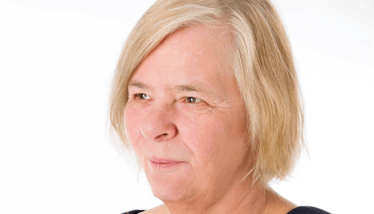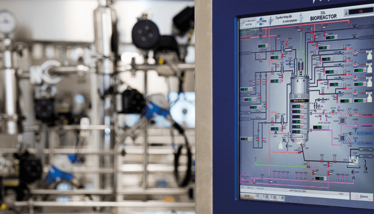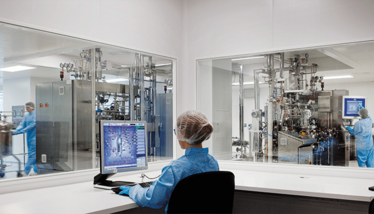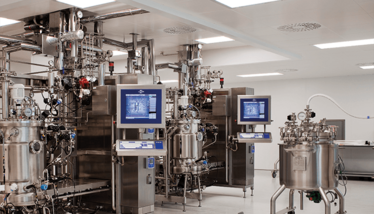The Science of Sugar: Lessons Learned with Pauline Rudd
Pauline Rudd’s passion for glycans started early – as a teenager she experimented with extracting sugars from natural products in her kitchen. Today, she is a principal investigator at NIBRT – Ireland’s National Institute for Bioprocessing Research and Training. Here, she reflects on her early interest, and the complex but crucial role of glycobiology in biosimilar development.

Chemistry is fascinating... but wasn’t my first choice
As a child, I wanted to be a physicist. My uncle was a physicist and he and I used to talk physics every time we met. I joined the British Junior Astronomical Association, but it was very male dominated at the time; there were 48 boys... and me. I was never allowed to look down the telescope. I got into chemistry, and specifically sugars, because I could do it at home in my kitchen using very simple ingredients, like potato starch. I used to beg a few grams of this and that from the pharmacies in my hometown for my experiments. Eventually, a pharmacist suggested that I talk to his son, telling me: “he’s as crazy as you are!” We had similar interests, and while still in school started a company called Wessex Biochemicals to make rare sugars and sugar phosphates. I was about 14 years old and it was tremendous fun. Our main piece of equipment at the time was a washing machine with a heater and a side paddle, which we used to extraxt trehaose from hot ethanol and baker’s yeast.
Taking time out to raise a family doesn’t mean the end of your career
I went to the University of London to study chemistry and when I returned home, we continued to build the company, which was later sold to Sigma London. We bought the site, which Sigma still occupy in Poole and continued to run the science. After I had children, a lab was built for me at home so that I could combine work and motherhood. But eventually we moved and I couldn’t take the lab with me, so I was out of the lab for 15 years.
I did a lot of the things in the interim while looking after the children, including commercial analytical work and some forensic science projects. After the fourth child started school, I went back to full-time work in Oxford and was fortunate enough to obtain a place in Professor Raymond Dwek’s lab. Later, this became the Oxford Glycobiology Institute – of which he remains Director. After such a long career break, I’d never imagined that I’d be able to go back to working with sugars so I was very happy! That said, I had to work very hard to advance. I started out in Oxford as a glass washer, but eventually I was able to form my own group. Some 23 years later, 11 of us moved to Ireland to work with NIBRT – the National Institute for Bioprocessing Research and Training in Dublin. NIBRT provides unique training courses for people to learn how to operate the plants that produce new therapeutic drugs. My group mainly focuses on developing advanced glycoanalytical technologies, some of which have been commercialized by Waters Corporation, to analyze glycosylation in biotherapeutics and in systems biology, which sets out to link glycans with classes of molecules such as genes, proteins, transcription factors and lipids. This gives us information about the pathways that molecules take as they are made by cells. If a pathway is damaged in disease we can see the effects in the glycan structures.
Looking back, I have been very fortunate. Today, I think it is much harder to find a career path, even if you love science.
Sugars are complex – and they matter in drug development
At least 60 percent of natural proteins have sugars attached to them. These sugars are huge – often bigger than the proteins to which they are bound; they are molecules in their own right. They play a role in protecting proteins, but are also important in cell communication, signaling pathways, and in the immune system.
Many biotherapeutics are glycosylated proteins. Given that they are often delivered to the patient in large quantities, you need to be absolutely sure they will activate in the right place in the body and not cause unwanted effects. For example, many drugs target tumor cells; the antigen binding sites locate the tumour epitope and then the rest of the molecule can initiate a killing reaction. There are many interactions that an antibody can engage with once it’s bound to the target though so it is important to design an antibody that will not have adverse effects.
The sugar molecules, or oligosaccharides, are made up of branching chains of monosaccharide residues. The sequence and the way in which they are linked, as well as their number, can affect the protein in various ways, including its efficacy, stability and safety, so removing or changing sugars can have often have quite drastic effects. For example, erythropoietin, which is used to treat anemia and which has been associated with doping in cycling, has three huge oligosaccharies with 4 branches terminating with sialiic acid. The drug can stay in the patient for three hours, but if you remove this acid, it will be gone in three minutes – which doesn’t make for a very efficacious drug! In the worst case scenario, the wrong glycosylation profile can mean the patient has to receive high levels of the drug, which can cause them to raise an unwanted immune response.
When developing a biologic, attention must be paid to the structure of the molecule to ensure that it is safe. However, biologicals are sensitive and unwanted post-translational modifications can occur during bioprocessing. There is always some batch-to-batch variability in biomanufacturing, but you need to ensure that your glycosylation profile remains within a safe window. Consistent glycosylation is a generally a very good marker of the consistency of a bioprocess – and it is something that regulators pay close attention to. When submitting a drug for approval, you need to submit data around critical features of glycosylation.
Similarity comes in many shades
For those who aren’t chemists, the topic of glycosylation can often seem daunting and complicated, but it is actually not difficult to understand the basic science since many sugars are members of families of nested structures. In fact, I think we need more people to understand the topic, especially given the increasing number of small companies and start-ups that want to get into the biosimilar space. Not everyone appreciates how challenging matching a glycosylation profile of a biosimilar to an innovator product can be.
Start-up companies focusing on biosimilars sometimes leave glycosylation studies until the very last minute. Developing a biopharmaceutical is incredibly challenging, and sometimes there is an assumption that developing a biosimilar is easy in comparison, since you are copying an already developed product. The difficulty comes in ensuring that your biosimilar has the same protein and glycosylation profile as the originator drug, within specified limits. In this regard, the innovator company perhaps had the easy job – they made the drug and showed that it was safe and non-toxic. The glycosylation profile came out as it did, and there was no need to match it to anything else. Often, a biosimilar developer may think they have copied a biological drug, but their process may be very different – and so too may the glycosylation profile. Given all the different variables in processing, you can end up creating 100s of clones that aren’t actually similar to the innovator product at all, which wastes a lot of time. Scientists do try to think about the problem rationally, but working with biological products is always challenging. If you’re new to the area (and even for experienced scientists), understanding and controlling your glycosylation profile can be a nightmare – you’ll need to dredge scientific literature to understand what conditions promote the glycosylation you nrrd and learn to understand your sugars and how they affect your drug.
All of this said, you also have to bite the bullet and try out some process conditions or gene editing! The innovators aren’t going to tell you what they did so you have to try things out and learn for yourself how they affect glycosylation.


Pauline Rudd’s Reading Recommendation
For those wanting to know more about glycosylation, I recommend the following review, which was written by a group that I am privileged to be associated with in the Bioprocessing Technology Institute in A*Star, Singapore; I am a visiting investigator.
P Zhang et al., “Challenges of glycosylation analysis and control: an integrated approach to producing optimal and consistent therapeutic drugs”, Drug Discov. Today, 21, 740-765 (2016). PMID: 26821133.
Analytical technology is always advancing
The most common techniques for analyzing glycosylation profiles are liquid chromatography (LC) and mass spectrometry (MS). Capillary electrophoresis is also important. In a nutshell, glycan analysis is all about separation. Different separation techniques give you different information. LC, for example, separates oligosaccharides on the basis of shape, charge and hydrophobic and hydrophilic surfaces. Mass spectrometry, on the other hand, provides information about composition; it will tell you how much your sugar weighs and you can work out which mono-saccharides are there, but it won’t always tell you whether its glucose or galactose, or the way in which they are linked together. For that, you need more sophisticated technology that can fragment or break the sugar into pieces. These pieces give you the sequence and linkage of the sugars.

Large companies can afford to have many instruments to provide different information, but smaller companies can find it more difficult to invest in equipment. In my group at NIBRT, we have access to a lot of equipment so we are often asked to help out smaller companies (as well as larger one too).
One challenge with the newest analytical equipment, however, is the sheer volume of data generated. It is important to remember that some aspects of glycosylation may not really affect the product – what the regulators care about are the critical features that affect safety and efficacy, such as antigenic epitopes.
Several vendors have developed really good workflows for their equipment (some of which we’ve helped to establish). We worked with Waters Corporation to establish an effective LC-MS workflow, where every sample goes straight from the LC onto the coupled MS, and then the information from both are lined up by the informatics program to give orthogonal confirmation of structure. This type of continuous bioinformatics is very important to interpret large data sets and to obtain GMP compliant information.
Biosimilars can be made better
When developing a biosimilar and studying glycosylation profiles, there is an opportunity to create something that is more effective than the originator drug – a so-called ‘biobetter’. For example, it may be possible to optimize the glycosylation profile to make the drug more active.
Making a biobetter, however, involves more regulatory hurdles; it’s easier not to change anything if it will involve new clinical trials, which is a shame, especially in an age where we are seeing a lot of new gene-editing technologies that can be useful when developing an optimized glycosylation profile. If you are changing non-critical features, then regulators tend to be more tolerant, but if it’s too different then you can run into problems – and you may need to conduct clinical studies. Regulators tend to treat differences on a case-by-case basis, so the outcome can vary.
Whether developing a biosimilar or a biobetter, it is important to start talking to regulators sooner rather than later – regulators are usually very helpful because they too want more of these drugs on the market. Glycosylation studies can be left to the end of the developmental process, but that can be a mistake; there is a real risk of spending all your time, effort and money, only to find that regulators will never approve the drug because of its glycosylation profile.
Pauline Rudd obtained a BSc in Chemistry at the University of London and a PhD in Glycobiology at the Open University, UK. She was a Founding Scientist of Wessex Biochemicals (later Sigma London), Visiting Research Associate at The Scripps Research Institute, CA, Visiting Professor of Biochemistry at Shanghai Medical University PRC, Visiting Scientist at Ben Gurion University of the Negev, Israel and Erskine Visiting Fellow, Canterbury University, Christchurch, New Zealand. She is a Fellow of the Royal Society of Medicine, London and a Visiting Professor at St. George’s Hospital, London and an Adjunct Professor at North Eastern University, Boston. She has more than 200 scientific publications and given over 200 lectures and seminars at international meetings. In 2010 she was awarded the James Gregory Medal and an Agilent Thought Leader award.



















